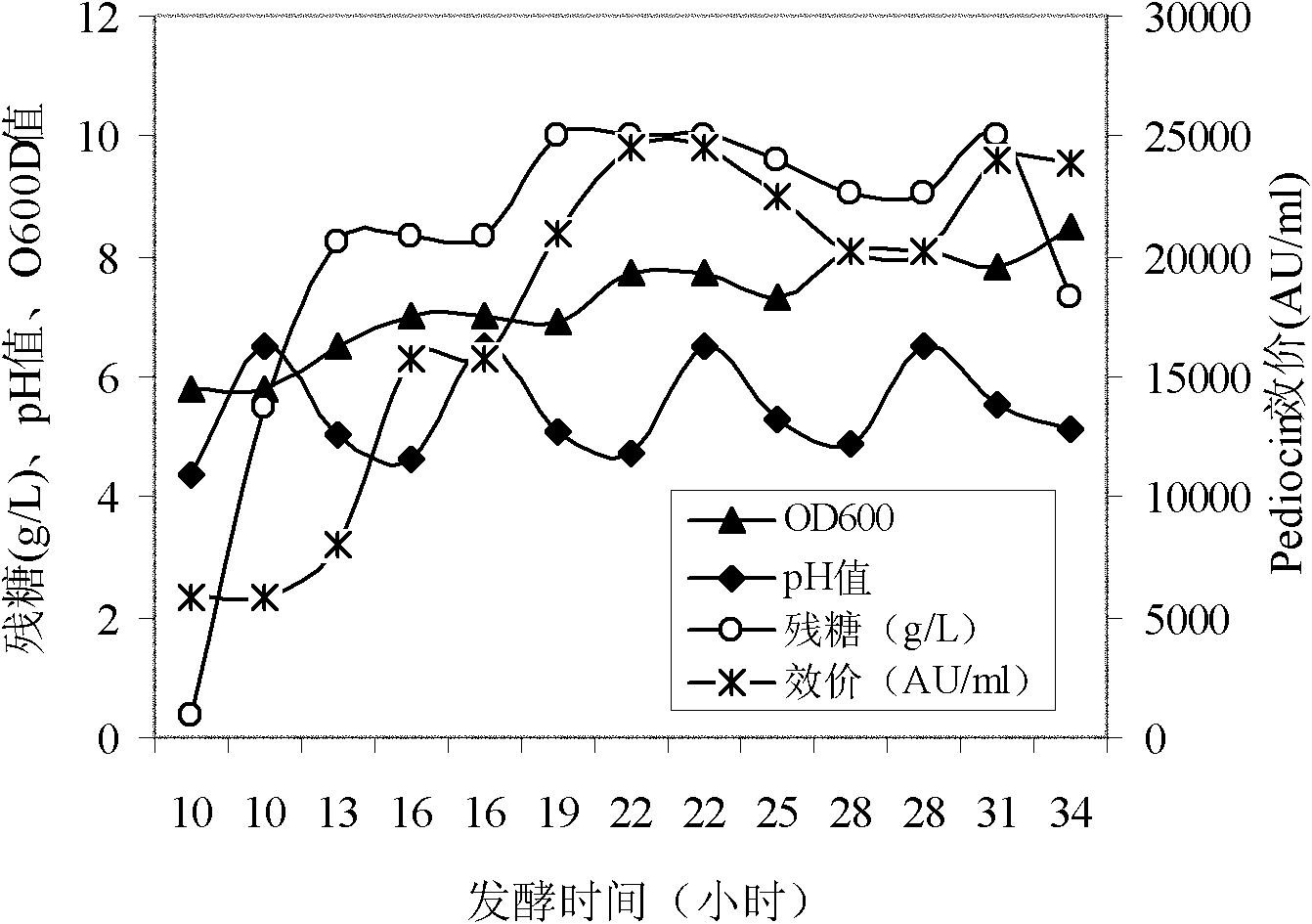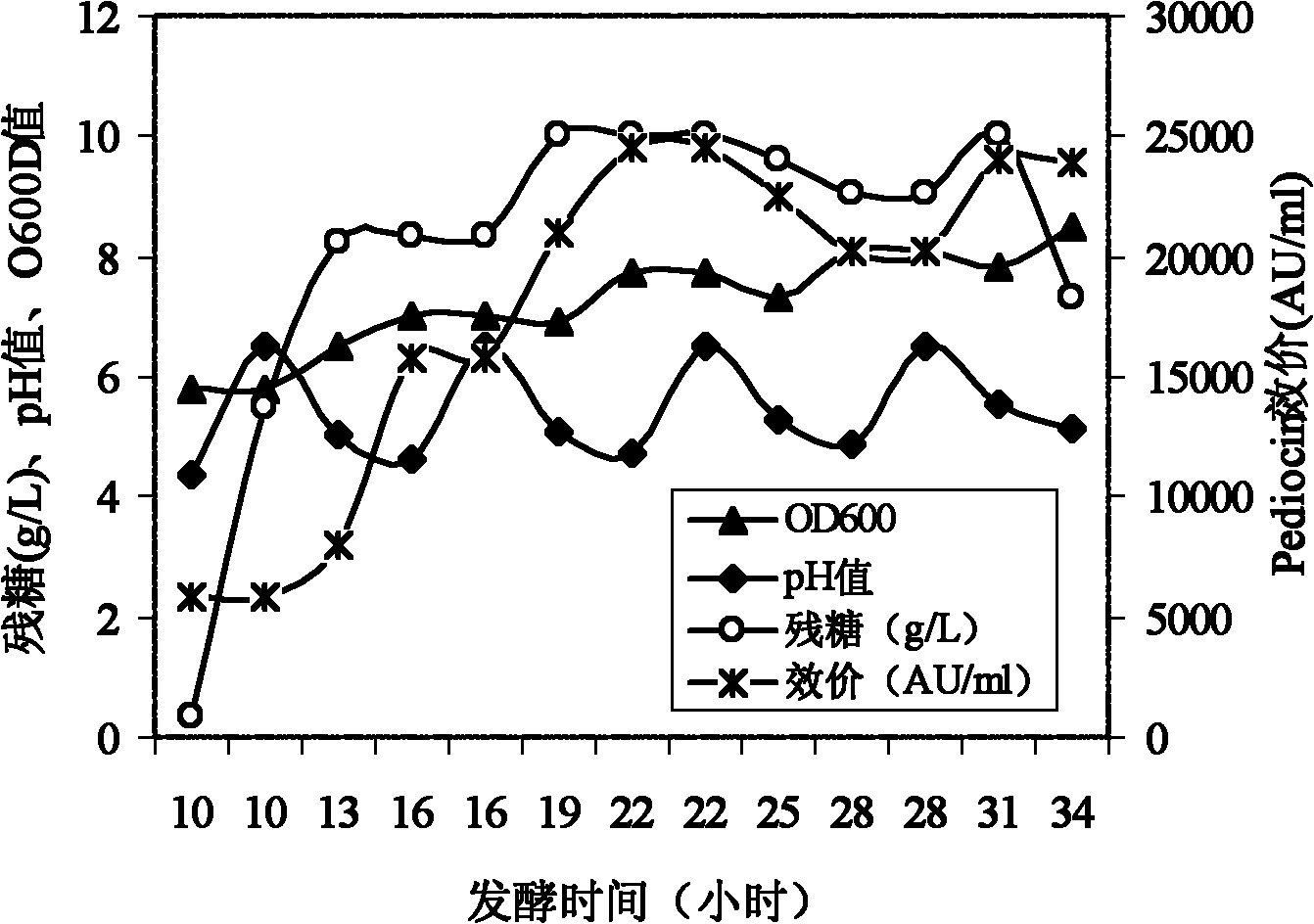Method for producing pediococcusacidilactici by accumulation
A technology of pediocin lactate and inoculum amount, which is applied in fermentation and other directions, can solve the problems of complex operation process, lack of large-scale proliferation of bacteria, long fermentation cycle, etc., and achieve high titer effect
- Summary
- Abstract
- Description
- Claims
- Application Information
AI Technical Summary
Problems solved by technology
Method used
Image
Examples
Embodiment 1
[0020] Take 200 μl of Pediococcus lactis preserved in a refrigerator at -20°C and inoculate it into the improved MRS shake flask medium. The medium composition is (g / L): glucose 15.0, peptone 10.0, beef extract 10.0, yeast extract 5.0, (NH 4 ) 2 HC 6 h 5 o 7 2.0, Tween 801.0, H 3 COONa·3H 2 O 5.0, K 2 HPO 4 ·3H 2 O 2.0, MgSO 4 ·7H 2 O 0.58, MnSO 4 ·H 2 O 0.25, distilled water 1000, the pH value was adjusted to 6.5 with 3mol / L hydrochloric acid solution and 3mol / L NaOH solution.
[0021] The Pediococcus LH31 cultivated above was inoculated in a 3.7L fermenter, the inoculum amount was 4wt% based on the volume of the medium, and the initial medium of the fermenter was an improved MRS liquid medium with a pH value of 6.5;
[0022] When the pH value of the fermented liquid drops to 4.2, start feeding. The feeding medium consists of glucose 350g / L and peptone 100g / L. Between 5-10g / L.
[0023] When the pH value of the fermentation broth dropped to 4.5, the pH value of t...
Embodiment 2
[0027] Take 200 μl of Pediococcus lactis preserved in a refrigerator at -20°C and inoculate it into the modified MRS shake flask medium. The medium composition is (g / L): glucose 20.0, peptone 10.0, beef extract 10.0, yeast extract 5.0, (NH 4 ) 2 HC 6 h 5 o 7 2.0, Tween 801.0, H 3 COONa·3H 2 O 5.0, K 2 HPO 4 ·3H 2 O 2.0, MgSO 4 ·7H 2 O 0.58, MnSO 4 ·H 2 O 0.25, distilled water 1000, the pH value was adjusted to 6.5 with 3mol / L hydrochloric acid solution and 3mol / L NaOH solution.
[0028] The Pediococcus LH31 cultivated above was inoculated in a 3.7L fermenter, and the inoculation amount was 4% based on the volume of the medium, and the initial medium of the fermenter was an improved MRS liquid medium, and the pH value was 6.5;
[0029] When the pH value of the fermentation broth dropped to 4.5, feeding was started, and the feeding medium consisted of glucose 300g / L and peptone 40g / L. Feeding adopts a constant-speed feeding method, so that the residual glucose conce...
Embodiment 3
[0034] Take 200 μl of Pediococcus lactis preserved in a refrigerator at -20°C and inoculate it into the modified MRS shake flask medium. The medium composition is (g / L): glucose 18.0, peptone 10.0, beef extract 10.0, yeast extract 5.0, (NH 4 ) 2 HC 6 h 5 o 7 2.0, Tween 801.0, H 3 COONa·3H 2 O 5.0, K 2 HPO 4 ·3H 2 O 2.0, MgSO 4 ·7H 2 O 0.58, MnSO 4 ·H 2 O 0.25, distilled water 1000, the pH value was adjusted to 6.5 with 3mol / L hydrochloric acid solution and 3mol / L NaOH solution.
[0035] The Pediococcus LH31 cultivated above was inoculated in a 3.7L fermenter, and the inoculation amount was 4% based on the volume of the medium, and the initial medium of the fermenter was an improved MRS liquid medium, and the pH value was 6.5;
[0036] When the pH value of the fermentation broth dropped to 4.1, feeding was started, and the feeding medium consisted of glucose 400g / L and peptone 80g / L. Feeding adopts a constant-speed feeding method, so that the residual glucose conce...
PUM
 Login to View More
Login to View More Abstract
Description
Claims
Application Information
 Login to View More
Login to View More - R&D
- Intellectual Property
- Life Sciences
- Materials
- Tech Scout
- Unparalleled Data Quality
- Higher Quality Content
- 60% Fewer Hallucinations
Browse by: Latest US Patents, China's latest patents, Technical Efficacy Thesaurus, Application Domain, Technology Topic, Popular Technical Reports.
© 2025 PatSnap. All rights reserved.Legal|Privacy policy|Modern Slavery Act Transparency Statement|Sitemap|About US| Contact US: help@patsnap.com


